Salami Rocket: Unterschied zwischen den Versionen
Amir (Diskussion | Beiträge) |
Amir (Diskussion | Beiträge) |
||
| Zeile 107: | Zeile 107: | ||
* [http://www.nakka-rocketry.net/ Very helpful articles of Richard Nakka about his experimental rockets] | * [http://www.nakka-rocketry.net/ Very helpful articles of Richard Nakka about his experimental rockets] | ||
* [http://www.modellraketen.info/knowhow.html Rocketry know-how DB (DE)] | * [http://www.modellraketen.info/knowhow.html Rocketry know-how DB (DE)] | ||
* [http://64.41.64.113/home/tips.html Model Rocketry Tips] | |||
* [http://www.pcprg.com/rocketre.htm Building a Model Rocket Parachute Recovery System by Dr. Jean Potvin] | |||
* [http://www.grc.nasa.gov/WWW/K-12/airplane/rktthsum.html Rocket thrust Equations] | |||
[[Kategorie:Projekte]] | [[Kategorie:Projekte]] | ||
Version vom 28. Juli 2009, 18:04 Uhr
WTF?

Oxydizer
I chose N2O over O2 because although N2O carries a lot of conjectural inert nitrogen (64%) oxygen is much harder to handle (tank filling, storage & injection). Additionally the nitrogen, though not participating in combustion, raises the fuel erosion rate and cooles the nozzle enough to reuse it many times. Since the alternatives i found are quite expensive, i use the nitrous oxyde of whipped-cream chargers. By the way, never search for "Sahnespender" at google.
Fuel
Salami: High efficency hydrocarbon based fuel ;)
Simulation
Im using RockSim to simulate the flight stability of the rocket. The behaviour of the N20/ hybrid motor is simulated by an external model programmed in C++.
Parts
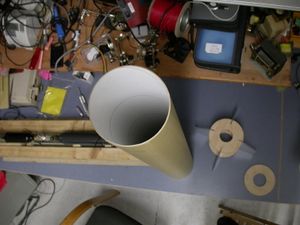
All parts directly participating in the combustion would have to sustain at least 51 bar (vapor pressure of N20 at 20°C) but for reasons of safety i assume 200bar as the minimum.
- Run Tank: A light-weight container for the oxydizer capable of sustaining enough pressure
- Throttle Valve: A valve to allow precise regulation of the oxydizer flow from the run tank to the combustion chamber.
- Injector: Aids in vaporizing the (still) liquid oxydizery.
- Combustion Chamber: Where the oxydizer/fuel mix burns. Additionally to pressure (same amount as for the run tank) it has to sustain heat.
- Nozzle: An opening that dramatically accelerates the hot gas escaping the combustion chamber.
- Ignitor: Preheating the fuel and initializing combustion.
- Body tube: Enhances airodynamic properties of the rocket and encapsulates the motor.
- Motor mount: Anchors the motor within the body tube
- Fins: Enhances airodynamic/stability properties of the rocket.
- Recovery System (parachute): Enables slow decent after burn-out for safety and reusability
- Tail camera: It's all about the nice view
- Altimeter: Measurement concludes the fate of the cat
- Electric beacon: Transmits a signal to ease finding the landing site.
- Filling system: Pipework to fill the run tank with nitrous oxyde from whipped cream chargers.
Run Tank
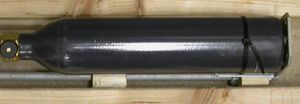
Smart Parts C02 aluminium tank for paintball guns with on/off valve.
- Capacity: 591ml (20 oz)
- Connector: 1,27cm (1/2")
- Max Pressure: 200bar
Throttle valve
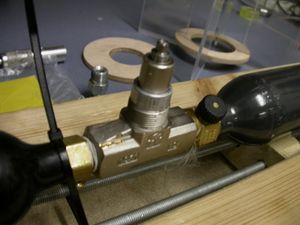
An adjustable throttle valve ([1]) intended for use in hydraulics.
- Connector: 1,27cm (1/2")
- Flow rate: 45 l/min
- Working pressure: 350 bar
Injector
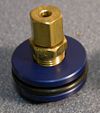
- Diameter: 54mm
Combustion Chamber
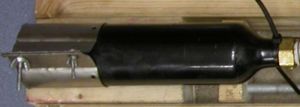
C02 aluminium tank for paintball guns without on/off valve.
- Capacity: 255ml (9 oz)
- Connector: 1,27cm (1/2")
- Max Pressure: 200bar
Nozzle

SKR-54NZL graphite nozzle
- Diameter: 54mm
Ignitor
None selected yet.
Body tube
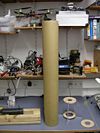
Cardboard tube, intended for postal delivery.
- Dimension: 1000 x 140 x 3 mm
Motor mount & Fins

Wooden centering rings and perspex fins, precisely milled with a CNC machine.
Recover System
None specified/selected yet.
Links
- Basic concept of hybrid rockets at wikipedia
- Excellent tech papers on calculating, planing and building hybrid rockets
- Very helpful articles of Richard Nakka about his experimental rockets
- Rocketry know-how DB (DE)
- Model Rocketry Tips
- Building a Model Rocket Parachute Recovery System by Dr. Jean Potvin
- Rocket thrust Equations